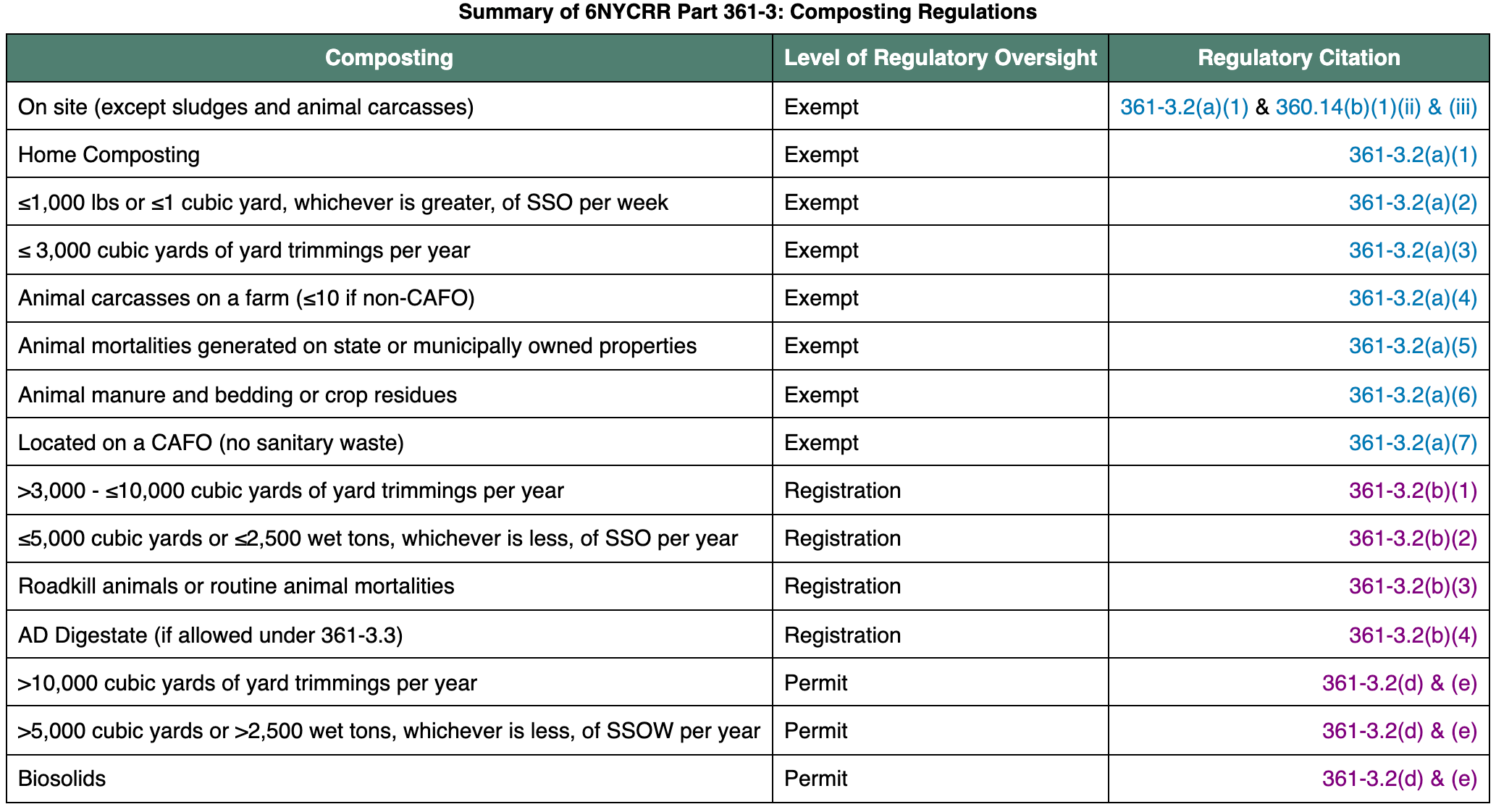Seeking to decrease the need for waste disposal services in and outside of state lines, New York touts a materials management hierarchy of reduction and reuse, followed by recycling, with the latter including composting. The NYS Department of Environmental Conservation asserts that promoting the recycling of organic materials through “composting, anaerobic digestion, land application, and other organics recycling technologies” is highly important since pursuing these practices “reduces the generation of greenhouse gases; creates soil amendments, energy and jobs; and reduces reliance on waste disposal.”
NYS Composting Regulations
New York requires agricultural composters who accept any amount of food scraps from off-site to apply for a permit. In addition to the permit requirement, composters must adhere to specific performance standards, including methods of vector and pathogen reduction. Some non-food materials — including crop residues and animal manure, as well as no more than 3,000 cubic yards of yard trimmings per year — may be conditionally exempt from the permit requirement.
DEC Regulations and Enforcement Chapter IV – Quality Services, Subpart 361-3.2: “Composting Facilities – Exemptions and Registration” lists exemptions as:
(a) Exempt facilities.
The following facilities are exempt from this Subpart when operated in a manner that does not produce vectors, dust or odors that unreasonably impact neighbors of the facility, as determined by the department, and when no waste accepted remains on-site for more than 36 months. No more than one exempt facility specified in this section can be located on geographically contiguous land owned or operated by the same person.
(1) A composting facility located at a site controlled by the waste generator, in accordance with section 360.14(c)(1) of this Title.
(2) A composting facility that accepts, measured on a monthly average, no more than 1,000 pounds or 1 cubic yard, whichever is greater, of SSO per week provided no more than 2,000 pounds are accepted in any one week. Sufficient bulking agent must be used to provide proper aeration and control leachate migration.
(3) A composting facility that accepts no more than 3,000 cubic yards of yard trimmings per year. This quantity does not include tree debris that is not intended for composting. For these facilities, precipitation, surface water, and groundwater that has come in contact with yard trimmings or the resultant product is not considered leachate; however, it must be managed within the site and must not enter a surface waterbody or a conveyance to a surface waterbody, or cause a violation of water quality standards promulgated in Part 750 of this Title.
(4) A composting facility located on a farm for animal carcasses. If the farm is not located on a concentrated animal feeding operation (CAFO), no more than 10 carcasses per year can be from off-site sources and the animal carcasses must be placed within the compost pile on the day received.
(5) A composting facility on property controlled by a State agency or a municipal entity for animal carcasses generated on properties under their control.
(6) A composting facility for animal manure and bedding or crop residues.
(7) A composting facility located on a CAFO, provided the waste accepted is limited to manure, food processing waste, fats, oil, grease, and other organic wastes without sanitary content.
Although New York requires certain facilities to register, some may still be exempt from applying for a permit as outlined below:
(b) Registered facilities.
Facilities of the following types are subject to the registration provisions of section 360.15 of this Title unless otherwise exempt. Each facility must comply with the criteria in section 360.19 of this Title and the operational criteria in this subdivision.
(1) A composting facility that accepts more than 3,000 cubic yards but not more than 10,000 cubic yards of yard trimmings per year, either processed or unprocessed. This quantity does not include tree debris that is not intended composting. The windrows must be turned a minimum of two times per year. For these facilities, precipitation, surface water, and groundwater that has come in contact with yard trimmings or the resultant compost is not considered leachate, but must be managed in a manner acceptable to the department.
(2) A composting facility that accepts no more than 5,000 cubic yards or 2,500 wet tons, whichever is less, of SSO per year, provided that no more than 800 cubic yards are accepted in any month. The facility must have, and use, at least twice as much bulking agent, by volume, as organic waste. The facility must effectively remove non-processibles that may be present within the SSO. The facility must effectively remove non-processible material that can be present with the SSO.
(3) A composting facility for road-killed animals or routine animal mortalities.
(4) A composting facility for digestate, if allowed under section 361-3.3 of this Subpart
Composters who do not qualify for exemption or registration must submit an application for a permit, which includes detailed information such as: a map of the facility, drainage characteristics, processing and storage areas, a description of access roads, pre-processing and post-processing methods, and dimensions of the windrows. New York regulations also specify that applications describe the point of generation of the food scraps accepted, as well as outline a plan to reduce pathogenic organism content, among other requirements.

Summary table from NYS Dept. of Env. Conservation website, last accessed July 2021.
More Information
- New York Organic Waste Facility Regulations (Chapter 4 – Quality Services, Subpart 361-3: Composting Facilities)
- Map of New York State’s Compost Facilities from Cornell’s Waste Management Institute
- New York State Department of Environmental Conservation – Composting & Organic Materials Management
—————————————
Original post from July 30, 2012
Updated July 26, 2021


